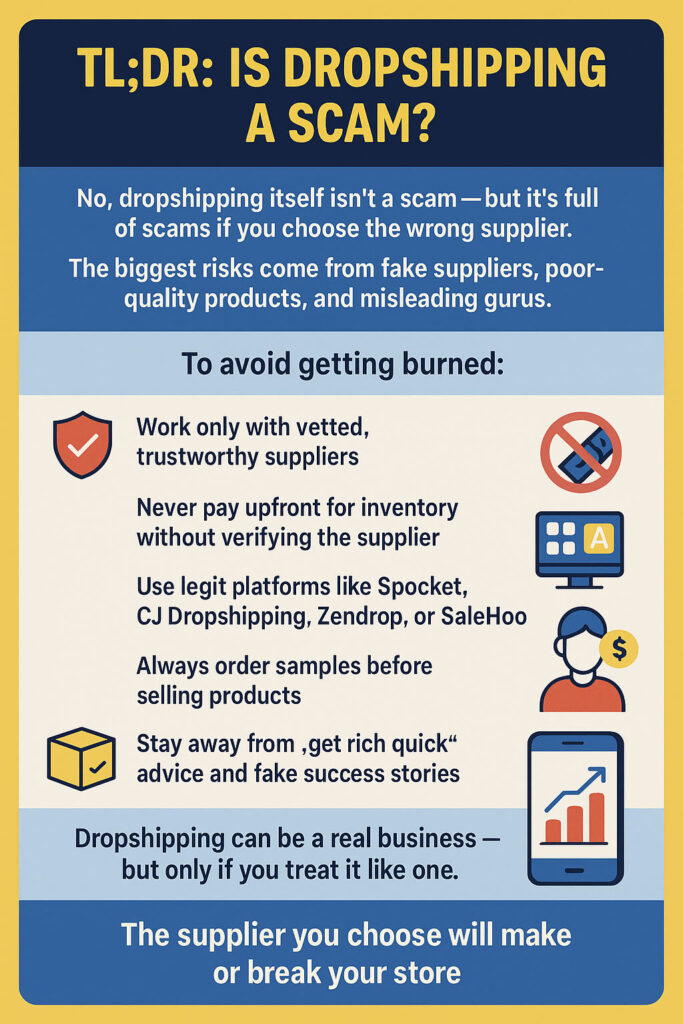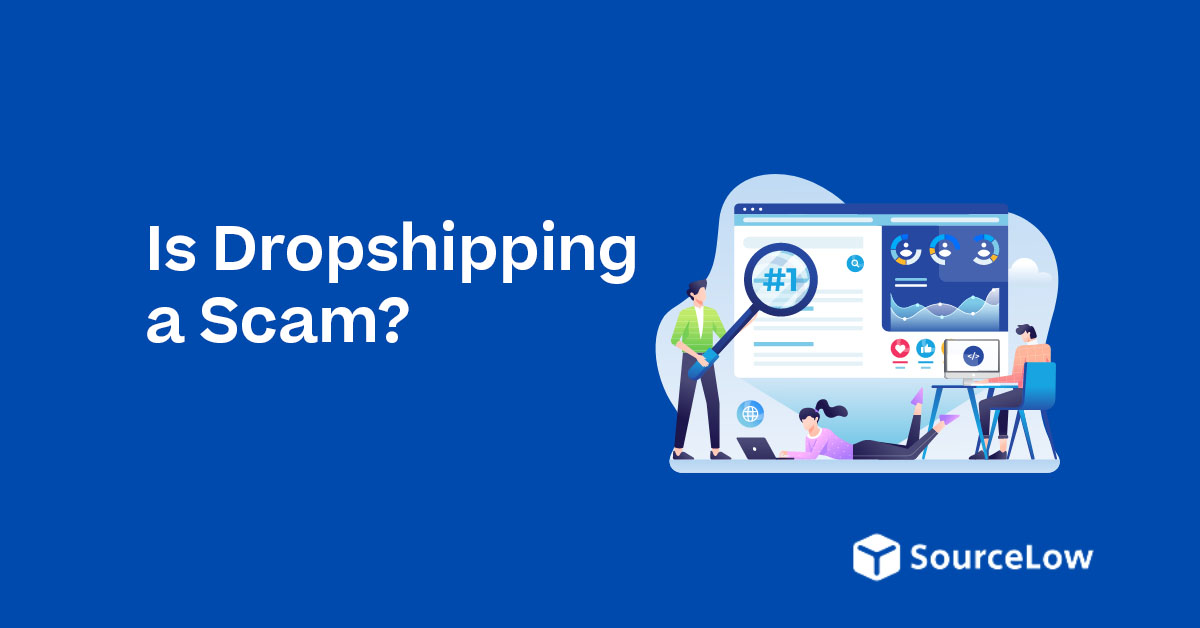Disclosure: We may earn a commission or fee from some of the links in our content. However, this does not affect our recommendations. Learn more.
Dropshipping is one of the most accessible online business models. But with its low barrier to entry, it’s also full of traps — mainly scam suppliers, fake tools, and empty promises.
At SourceLow, we’ve researched hundreds of suppliers, platforms, and tools since 2020. We’ve seen both the legitimate companies that support successful sellers, and the bad actors that ruin ecommerce businesses. So if you’re asking, “Is dropshipping a scam?”, the short answer is no — but it’s full of opportunities to get scammed if you’re not careful.
This guide will break down the real risks, explain how to spot fake suppliers, and help you choose genuine vendors to build a sustainable business.

TL;DR: Is Dropshipping a Scam?
No, dropshipping itself isn’t a scam — but it’s full of scams if you choose the wrong supplier. The biggest risks come from fake suppliers, poor-quality products, and misleading gurus.
To avoid getting burned:
- Work only with vetted, trustworthy suppliers
- Never pay upfront for inventory without verifying the supplier
- Use legit platforms like Spocket, CJ Dropshipping, Zendrop, or SaleHoo
- Always order samples before selling products
- Stay away from “get rich quick” advice and fake success stories
Dropshipping can be a real business — but only if you treat it like one.
The supplier you choose will make or break your store.
What Is Dropshipping — And Why People Call It a Scam
Dropshipping is a retail model where you sell products without stocking inventory.
When a customer places an order, you forward it to a supplier who ships it directly to them. You make the profit on the difference between your retail price and wholesale cost.
It’s a real model, used by both beginners and large businesses. But the problem is that many beginners fall for poor advice and unreliable suppliers.
Why Some People Think Dropshipping Is a Scam
- Poor product quality. Many dropshippers use low-quality suppliers from marketplaces like AliExpress, which leads to defective items and unhappy customers.
- Slow shipping times. International shipping from China can take 2–4 weeks, which creates refund requests and PayPal disputes.
- Scam suppliers. Some suppliers take your money but never ship the product or disappear entirely after receiving orders.
- Fake gurus and course sellers. Social media is filled with creators who promise overnight success with little to no effort, leading people into unrealistic expectations.
- Chargebacks and fraud. When customers are unhappy, they file disputes. Too many disputes, and your payment processor may freeze your account or hold funds.
It’s not the business model that’s the issue. It’s how it’s executed — especially the suppliers you work with.
The Truth: Dropshipping Is a Legitimate Model — If Done Right
There are thousands of ecommerce sellers running legitimate dropshipping stores using verified platforms, vetted suppliers, and reliable systems. Companies like Wayfair, Zappos, and even Amazon use forms of dropshipping.
At SourceLow, we vet every supplier we recommend, and we’ve seen legitimate businesses use dropshipping successfully to scale to six or seven figures. Here’s what a legitimate dropshipping process looks like:
A Legitimate Dropshipping Store Setup
| Step | Task |
|---|---|
| 1 | Choose a niche based on demand and supplier availability |
| 2 | Set up a store using Shopify, WooCommerce, or BigCommerce |
| 3 | Find vetted, trustworthy suppliers from platforms like Spocket or CJ Dropshipping |
| 4 | Import products with real shipping times and clear descriptions |
| 5 | Run ads or organic marketing to bring traffic |
| 6 | Handle customer support, returns, and feedback professionally |
| 7 | Scale based on profit margins and repeat customer performance |
Instead of chasing quick money, you’re building a long-term asset.
Common Dropshipping Scams to Watch Out For
If you Google “dropshipping scam,” you’ll find countless horror stories. Most of them boil down to one thing: trusting the wrong supplier.
Here are the most common types of dropshipping scams and how they work:
1. Fake Dropshipping Suppliers
These are websites or individuals who pretend to be real suppliers but have no intention of shipping anything. They often look like wholesalers but are nothing more than scam operations.
Warning Signs:
- No real company name or registration info
- Only contactable via WhatsApp or email
- No product samples or reviews
- Poor website design and broken English
- Ask for high upfront payments
2. Bulk Order Traps
Some fake suppliers will require you to pay upfront for inventory, even though dropshipping should require no stock purchases. Once paid, they stop responding or ship fake products.
Red Flags:
- Large MOQs (Minimum Order Quantities) for each SKU
- “Exclusive distributor” claims that can’t be verified
- No return or refund policies
3. Reseller Directory Scams
Certain directories charge high fees for access to suppliers but don’t actually vet them. These directories often have outdated, irrelevant, or fake suppliers.
What to Avoid:
- Lifetime memberships for supplier access without real demos
- Platforms with no free trial or refund policy
- Limited or no support or contact information
How to Avoid Scam Dropshipping Suppliers
Choosing the right supplier can make or break your business. Here’s how to protect yourself and build on solid ground.
Step-by-Step Checklist to Vet a Supplier
| Criteria | What to Look For |
|---|---|
| Company Info | Real business address, contact details, and company registration |
| Reviews | Search Google, Reddit, and Facebook for past reviews and discussions |
| Refund Policy | A clear and fair return/refund policy |
| Sample Orders | Willing to send samples before bulk or repeated orders |
| Platform Integration | Works with Shopify, WooCommerce, etc. |
| Shipping Times | Offers ePacket, USPS, Royal Mail, or local warehouse options |
| Communication | Responds within 24 hours, provides tracking and invoices |
Tips for Finding Legitimate Suppliers
- Use supplier directories like SaleHoo, Inventory Source, or Syncee that vet their suppliers manually
- Stick to platforms like CJ Dropshipping, Spocket, DSers, or Zendrop which have supplier verification processes
- Order samples before selling anything on your store
- Search their company name + scam on forums and social media
- Avoid anything that sounds too good to be true — like 90% profit margins or same-day worldwide shipping for $1
Recommended Supplier Platforms
Here are a few trusted supplier platforms we’ve tested at SourceLow:
| Platform | Features | Starting Cost |
|---|---|---|
| CJ Dropshipping | No monthly fee, global warehouses, custom branding | Free |
| Spocket | US/EU suppliers, fast shipping, Shopify integration | Free / From $39.99/month |
| Zendrop | Automated fulfillment, US products, fast support | Free / From $49/month |
| Dropified | Product import automation, advanced order management | From $47/month |
| SaleHoo | Vetted supplier directory, training, support | $67/year |
These platforms vet their suppliers and typically reject unverified vendors. They’re not foolproof, but they drastically reduce your risk.
Real Dropshipping Scams: Case Studies and Reports
Here are some real examples of dropshipping scams and how they impacted sellers:
Case Study #1 – Maria’s Story (Shopify)
Maria was a Shopify dropshipper who sourced from a random AliExpress supplier. After 200+ orders, the supplier stopped replying. Products were never shipped. She lost over $7,500 in refunds and had her PayPal account frozen.
Lesson: Vet your supplier before scaling. Use sample orders, communicate frequently, and avoid suppliers who don’t offer order tracking.
Case Study #2 – CJ Dropshipping vs. AliExpress
A 2023 Reddit user compared CJ Dropshipping vs. AliExpress:
- AliExpress: Average shipping time was 21–28 days. 15% of orders arrived damaged.
- CJ Dropshipping: Average shipping time was 7–12 days with tracking. 0 damaged orders out of 40.
Lesson: Platform matters. Choose a supplier network with verified fulfillment centers and better logistics.
Case Study #3 – Facebook Ads and Refund Chaos
A beginner dropshipper scaled a product using TikTok ads without testing the supplier. As soon as orders hit 100/day, 30% of products didn’t ship. Facebook ad account was banned due to customer complaints.
Lesson: Scale only after you’ve confirmed the supplier can handle volume.
FAQs: Avoiding Dropshipping Scams
Is dropshipping a scam?
No. It’s a real ecommerce business model used by retailers worldwide. The scam happens when you use unverified suppliers or follow bad advice.
How do I know if a dropshipping supplier is fake?
Look for company registration, contact info, product samples, and refund policies. Avoid any supplier who refuses to share basic information.
What is the safest way to find dropshipping suppliers?
Use platforms that verify their suppliers, like Spocket, CJ Dropshipping, and SaleHoo. Always order a sample before adding products to your store.
Can I get my money back from a scam supplier?
If you paid via PayPal or credit card, you may be able to file a dispute. If you paid via wire or crypto, your chances are slim.
Final Thoughts
Dropshipping isn’t a scam. But it’s full of scammers if you don’t know what to look for.
If you take your time and work only with trusted suppliers, the business model can be legitimate, scalable, and profitable.
At SourceLow, we’ve spent years vetting suppliers, tools, and software to help sellers avoid common traps.
Follow the advice above, use only trusted supplier directories, and don’t skip the vetting process. Your reputation — and your business — depend on it.

